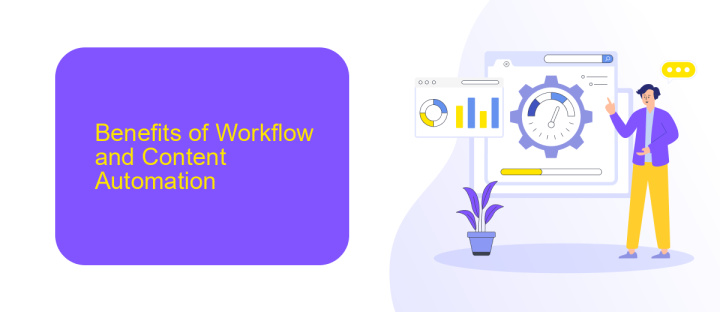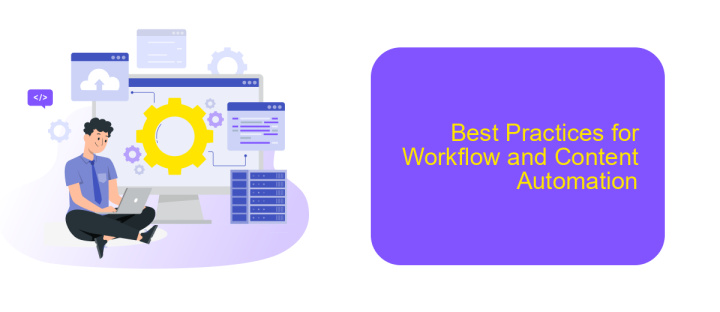Workflow and Content Automation
In today's fast-paced digital landscape, workflow and content automation have become essential tools for businesses seeking to enhance efficiency and productivity. By automating repetitive tasks and streamlining processes, organizations can focus on strategic initiatives and creative endeavors. This article delves into the benefits, tools, and best practices of workflow and content automation, offering insights to help your business thrive in a competitive environment.
Introduction to Workflow and Content Automation
Workflow and Content Automation (WCA) is revolutionizing how businesses manage their processes and digital content. By automating repetitive tasks, companies can significantly enhance productivity, reduce errors, and free up valuable time for more strategic activities. This transformation is particularly impactful in areas like marketing, where timely and accurate content dissemination is crucial.
- Streamlined processes
- Reduced manual errors
- Enhanced productivity
- Improved content management
One of the key components of WCA is the integration of various tools and platforms. Services like ApiX-Drive enable seamless integration between different applications, allowing for automated data transfer and synchronization. This not only simplifies workflows but also ensures that information is always up-to-date across all systems. By leveraging such integrations, businesses can create a cohesive and efficient digital ecosystem.
Benefits of Workflow and Content Automation

Workflow and content automation offers numerous benefits, including increased efficiency and productivity. By automating repetitive tasks, teams can focus on higher-value activities that require creativity and critical thinking. This leads to faster project completion times and a more streamlined workflow, ultimately saving time and reducing costs. Automation tools can also ensure consistency and accuracy in content creation and distribution, minimizing the risk of human error.
Another significant advantage is the seamless integration of various tools and platforms. Services like ApiX-Drive facilitate these integrations, allowing different applications to communicate and work together effortlessly. This not only enhances collaboration but also provides real-time data synchronization, ensuring that all team members are on the same page. Additionally, automation can improve scalability, enabling businesses to handle increased workloads without compromising quality. Overall, workflow and content automation empowers organizations to optimize their processes and achieve better outcomes.
Challenges of Implementing Workflow and Content Automation

Implementing workflow and content automation can significantly enhance efficiency, but it comes with its own set of challenges. Organizations often face difficulties when integrating automation tools with existing systems and processes.
- Complexity of Integration: Integrating new automation tools with legacy systems can be complex and time-consuming. Services like ApiX-Drive can simplify this process by providing seamless integration solutions.
- Data Security: Ensuring the security of sensitive data during automation is crucial. Automated systems must comply with data protection regulations to avoid potential breaches.
- User Adoption: Employees may resist changes brought by automation. Proper training and change management strategies are essential to ensure smooth adoption.
- Cost: Initial setup and maintenance costs for automation tools can be high. Organizations need to carefully evaluate the return on investment.
Despite these challenges, the benefits of workflow and content automation, such as increased productivity and reduced manual errors, make it a worthwhile investment for many organizations. By addressing these challenges strategically, businesses can fully leverage the potential of automation technologies.
Best Practices for Workflow and Content Automation

Implementing workflow and content automation requires a strategic approach to ensure efficiency and effectiveness. Start by analyzing your current processes to identify repetitive tasks that can be automated. This initial assessment will help you prioritize which workflows to automate first, based on their impact and complexity.
Next, choose the right tools and platforms that align with your business needs. Consider using ApiX-Drive, a powerful service that simplifies the integration of various applications, enabling seamless data transfer and automation. This can significantly reduce manual effort and minimize errors.
- Define clear objectives for each automated workflow.
- Ensure data accuracy by regularly monitoring and updating your integrations.
- Train your team to effectively use automation tools.
- Continuously review and optimize automated processes.
Finally, maintain flexibility in your automation strategy. As your business evolves, your workflow needs may change, requiring adjustments to your automation setup. Regularly revisit and refine your processes to ensure they continue to deliver optimal results.
Case Studies and Examples of Successful Workflow and Content Automation
One notable case study of successful workflow and content automation is from a digital marketing agency that streamlined their client onboarding process. By integrating ApiX-Drive, the agency automated data transfer between their CRM, email marketing platform, and project management tool. This integration reduced manual data entry, minimized errors, and accelerated the onboarding process by 40%. The automation not only saved time but also allowed the team to focus on strategic tasks, ultimately improving client satisfaction and retention.
Another example comes from an e-commerce business that leveraged content automation to enhance their customer engagement. By using a combination of ApiX-Drive and content management systems, they automated the creation and distribution of personalized marketing emails based on customer behavior. This approach led to a 25% increase in open rates and a 30% boost in sales conversions. The seamless integration facilitated by ApiX-Drive ensured that the right content reached the right audience at the right time, driving significant business growth.
- Automate the work of an online store or landing
- Empower through integration
- Don't spend money on programmers and integrators
- Save time by automating routine tasks
FAQ
What is Workflow and Content Automation?
Why is Workflow and Content Automation important?
How can I start implementing Workflow and Content Automation in my organization?
What are the key benefits of using a service like ApiX-Drive for automation?
Can Workflow and Content Automation be customized to fit specific business needs?
Apix-Drive will help optimize business processes, save you from a lot of routine tasks and unnecessary costs for automation, attracting additional specialists. Try setting up a free test connection with ApiX-Drive and see for yourself. Now you have to think about where to invest the freed time and money!


